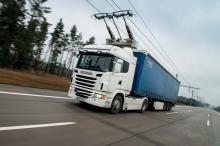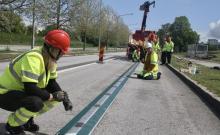Sweden’s two kilometre-long Elväg Gävle electric road test track, which runs along the E16 between Sandviken and Kungsgården, is to begin operation in June 2016, according to Processnet.
The project is managed by the Regional Development Council of Gävleborg (Region Gavleborg), which is financing it in partnership with the Swedish Transport Administration, Trafikverket, the Swedish Energy Agency, Swedish government agency for research and development Vinnova, Scania and Siemens. Other partners include st
Sweden’s two kilometre-long Elväg Gävle electric road test track, which runs along the E16 between Sandviken and Kungsgården, is to begin operation in June 2016, according to Processnet.
The project is managed by the Regional Development Council of Gävleborg (Region Gavleborg), which is financing it in partnership with the746 Swedish Transport Administration, 6301 Trafikverket, the Swedish Energy Agency, Swedish government agency for research and development Vinnova, 570 Scania and 189 Siemens. Other partners include steel companies Sandvik, Ovako, 2957 SSAB and Outokumpu
Electric trucks will use the road for seven days per month until 2018 and if the project goes well, the next goal is to electrify the entire route from the port of Gävle to Borlänge.
The project partners believe that using electricity, which they say is a cheaper source of energy than diesel, will reduce fossil fuel emissions by 80-90 per cent. They say it is climate-friendly, cost-effective way to combine the advantages of railways with the flexibility of trucks.
The project is managed by the Regional Development Council of Gävleborg (Region Gavleborg), which is financing it in partnership with the
Electric trucks will use the road for seven days per month until 2018 and if the project goes well, the next goal is to electrify the entire route from the port of Gävle to Borlänge.
The project partners believe that using electricity, which they say is a cheaper source of energy than diesel, will reduce fossil fuel emissions by 80-90 per cent. They say it is climate-friendly, cost-effective way to combine the advantages of railways with the flexibility of trucks.









